2022 HYUNDAI I20 Headlight
[x] Cancel search: HeadlightPage 171 of 444

6-43
06
OBI3050020OBI3050020
AUTO light position (if equipped)
When the light switch is in the AUTO
position, the parking (position) light and
headlights will be turned ON or OFF
automatically depending on the amount
of light outside the vehicle.
Even with the AUTO light feature
in operation, it is recommended to
manually turn ON the lights when driving
at night or in a fog, or when you enter
dark areas, such as tunnels and parking
facilities.
NOTICE
• Do not cover or spill anything on the
sensor (1) located on the instrument
panel.
• Do not clean the sensor using
a window cleaner, the cleanser
may leave a light film which could
interfere with sensor operation.
• If your vehicle has window tint or
other types of metallic coating on
the front windshield, the AUTO light
system may not work properly.
High beam operation
OBI3050021OBI3050021
To turn on the high beam headlight,
push the lever away from you. The lever
will return to its original position.
The high beam indicator will light when
the headlight high beams are switched
on.
To turn off the high beam headlight, pull
the lever towards you. The low beams
will turn on.
WARNING
Do not use high beam when there are
other vehicles approaching you. Using
high beam could obstruct the other
driver’s vision.
Page 172 of 444
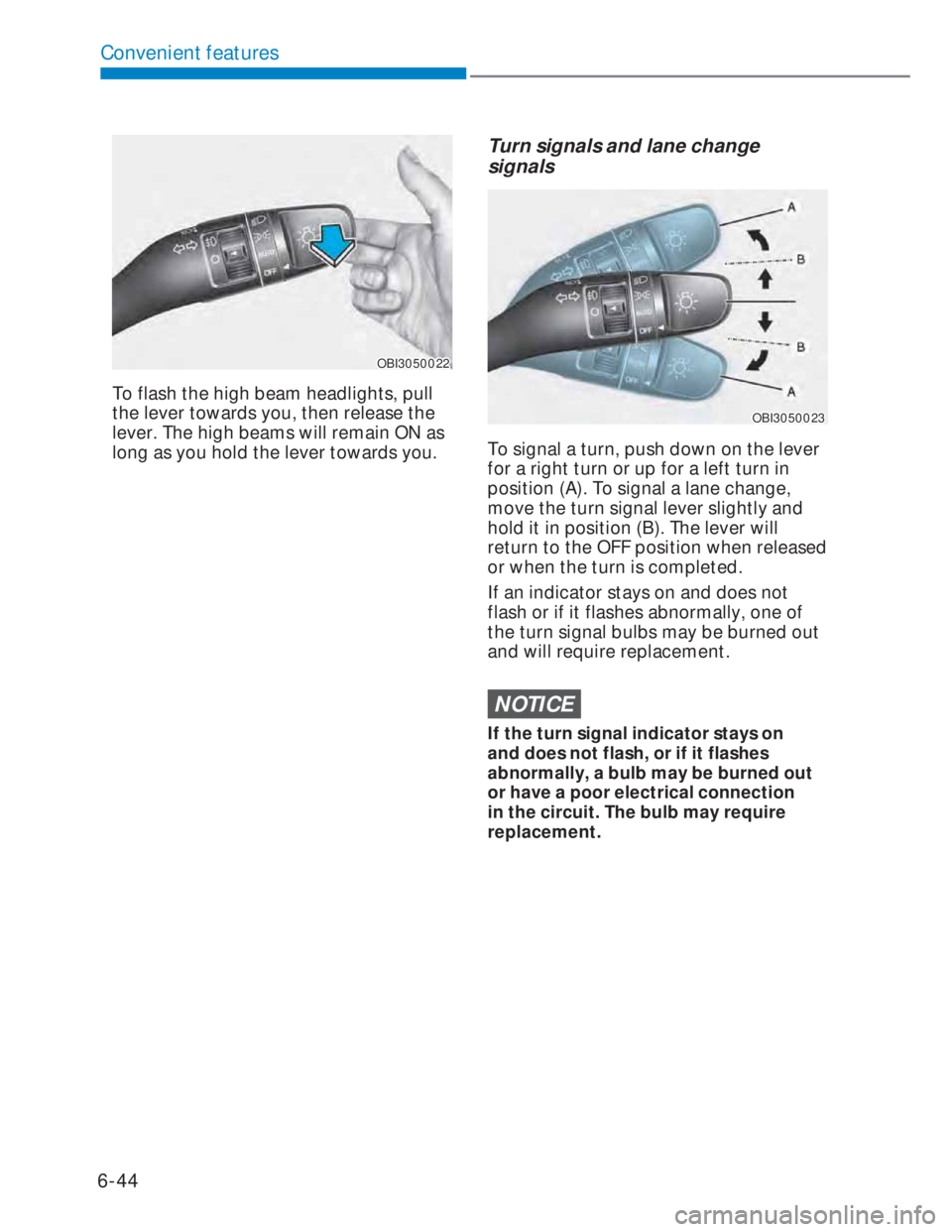
6-44
Convenient features
OBI3050022OBI3050022
To flash the high beam headlights, pull
the lever towards you, then release the
lever. The high beams will remain ON as
long as you hold the lever towards you.
Turn signals and lane change
signals
OBI3050023OBI3050023
To signal a turn, push down on the lever
for a right turn or up for a left turn in
position (A). To signal a lane change,
move the turn signal lever slightly and
hold it in position (B). The lever will
return to the OFF position when released
or when the turn is completed.
If an indicator stays on and does not
flash or if it flashes abnormally, one of
the turn signal bulbs may be burned out
and will require replacement.
NOTICE
If the turn signal indicator stays on
and does not flash, or if it flashes
abnormally, a bulb may be burned out
or have a poor electrical connection
in the circuit. The bulb may require
replacement.
Page 173 of 444
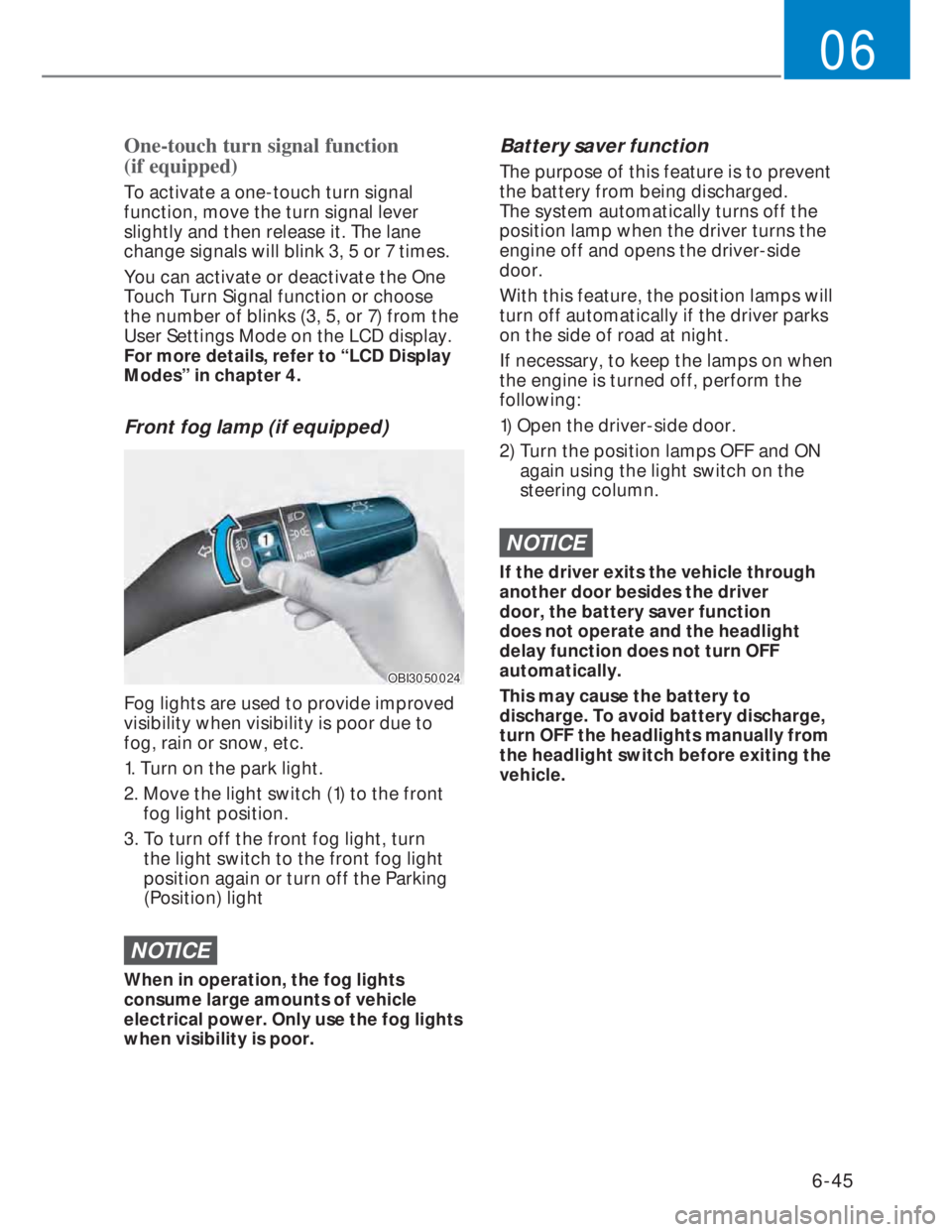
6-45
06
One-touch turn signal function
(if equipped)
To activate a one-touch turn signal
function, move the turn signal lever
slightly and then release it. The lane
change signals will blink 3, 5 or 7 times.
You can activate or deactivate the One
Touch Turn Signal function or choose
the number of blinks (3, 5, or 7) from the
User Settings Mode on the LCD display.
For more details, refer to “LCD Display
Modes” in chapter 4.
Front fog lamp (if equipped)
OBI3050024OBI3050024
Fog lights are used to provide improved
visibility when visibility is poor due to
fog, rain or snow, etc.
1. Turn on the park light.
2. Move the light switch (1) to the front
fog light position.
3. To turn off the front fog light, turn
the light switch to the front fog light
position again or turn off the Parking
(Position) light
NOTICE
When in operation, the fog lights
consume large amounts of vehicle
electrical power. Only use the fog lights
when visibility is poor.
Battery saver function
The purpose of this feature is to prevent
the battery from being discharged.
The system automatically turns off the
position lamp when the driver turns the
engine off and opens the driver-side
door.
With this feature, the position lamps will
turn off automatically if the driver parks
on the side of road at night.
If necessary, to keep the lamps on when
the engine is turned off, perform the
following:
1) Open the driver-side door.
2) Turn the position lamps OFF and ON
again using the light switch on the
steering column.
NOTICE
If the driver exits the vehicle through
another door besides the driver
door, the battery saver function
does not operate and the headlight
delay function does not turn OFF
automatically.
This may cause the battery to
discharge. To avoid battery discharge,
turn OFF the headlights manually from
the headlight switch before exiting the
vehicle.
Page 174 of 444
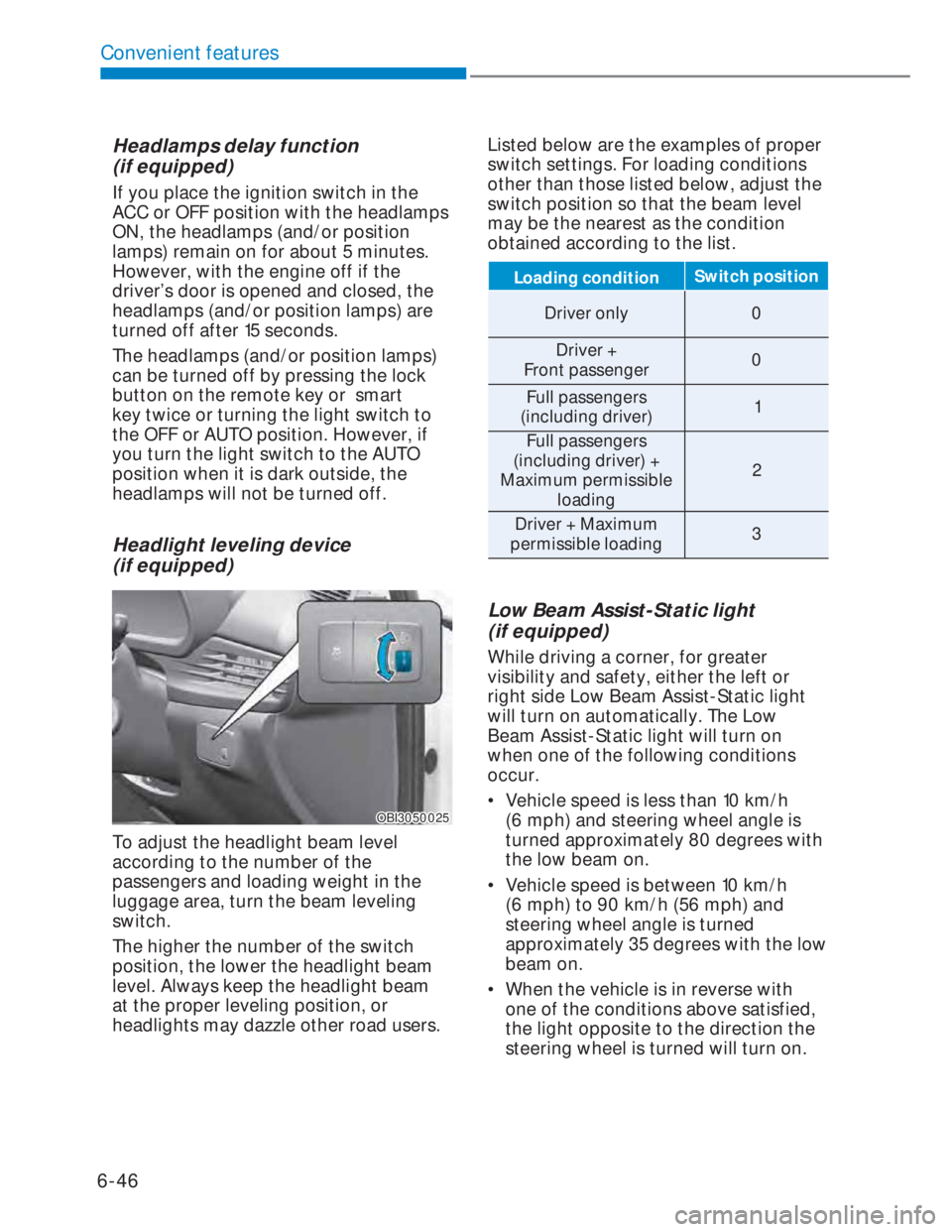
6-46
Convenient features
Headlamps delay function
(if equipped)
If you place the ignition switch in the
ACC or OFF position with the headlamps
ON, the headlamps (and/or position
lamps) remain on for about 5 minutes.
However, with the engine off if the
driver’s door is opened and closed, the
headlamps (and/or position lamps) are
turned off after 15 seconds.
The headlamps (and/or position lamps)
can be turned off by pressing the lock
button on the remote key or smart
key twice or turning the light switch to
the OFF or AUTO position. However, if
you turn the light switch to the AUTO
position when it is dark outside, the
headlamps will not be turned off.
Headlight leveling device
(if equipped)
OBI3050025OBI3050025
To adjust the headlight beam level
according to the number of the
passengers and loading weight in the
luggage area, turn the beam leveling
switch.
The higher the number of the switch
position, the lower the headlight beam
level. Always keep the headlight beam
at the proper leveling position, or
headlights may dazzle other road users.Listed below are the examples of proper
switch settings. For loading conditions
other than those listed below, adjust the
switch position so that the beam level
may be the nearest as the condition
obtained according to the list.
Loading conditionSwitch position
Driver only 0
Driver +
Front passenger0
Full passengers
(including driver)1
Full passengers
(including driver) +
Maximum permissible
loading2
Driver + Maximum
permissible loading 3
Low Beam Assist-Static light
(if equipped)
While driving a corner, for greater
visibility and safety, either the left or
right side Low Beam Assist-Static light
will turn on automatically. The Low
Beam Assist-Static light will turn on
when one of the following conditions
occur.
• Vehicle speed is less than 10 km/h
(6 mph) and steering wheel angle is
turned approximately 80 degrees with
the low beam on.
• Vehicle speed is between 10 km/h
(6 mph) to 90 km/h (56 mph) and
steering wheel angle is turned
approximately 35 degrees with the low
beam on.
• When the vehicle is in reverse with
one of the conditions above satisfied,
the light opposite to the direction the
steering wheel is turned will turn on.
Page 175 of 444
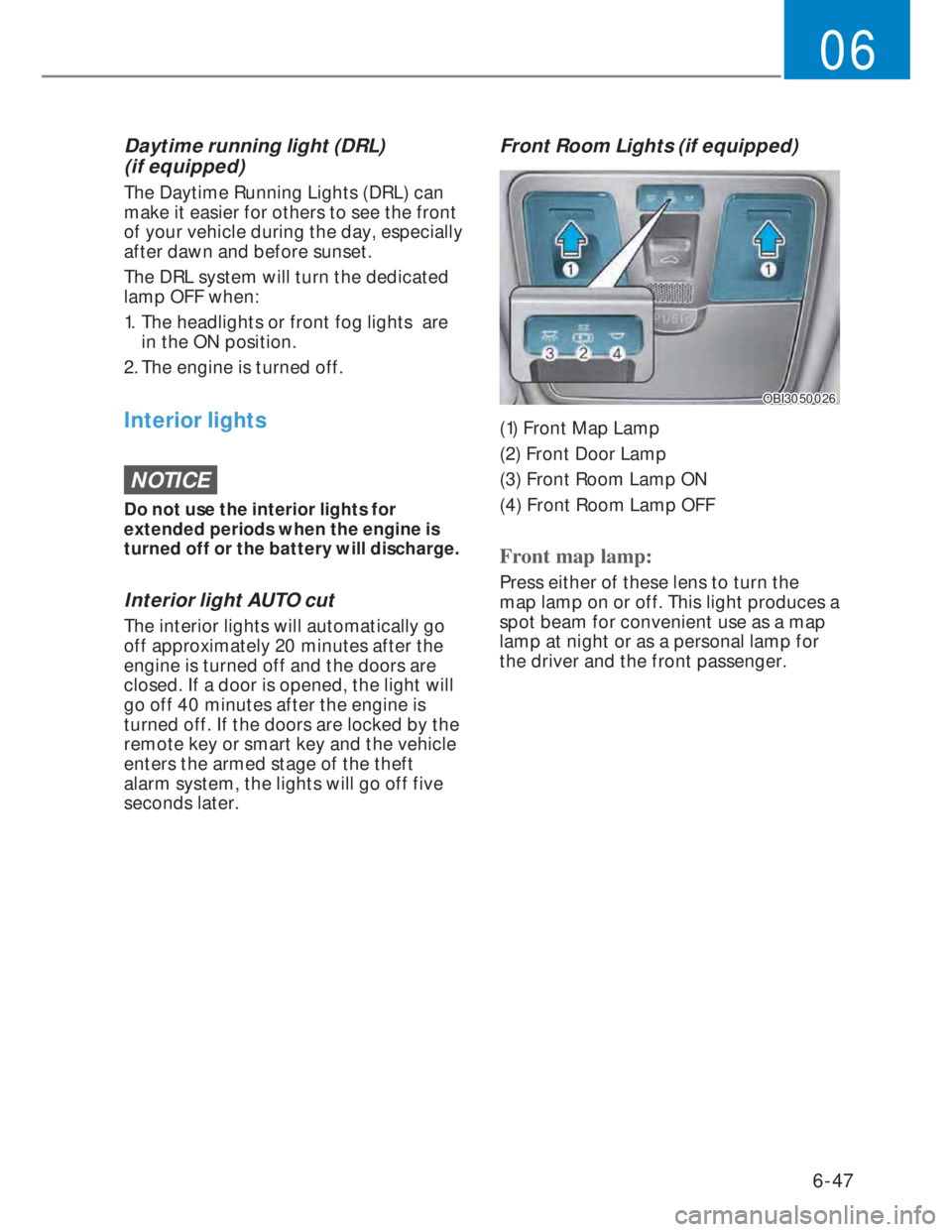
6-47
06
Daytime running light (DRL)
(if equipped)
The Daytime Running Lights (DRL) can
make it easier for others to see the front
of your vehicle during the day, especially
after dawn and before sunset.
The DRL system will turn the dedicated
lamp OFF when:
1. The headlights or front fog lights are
in the ON position.
2. The engine is turned off.
Interior lights
NOTICE
Do not use the interior lights for
extended periods when the engine is
turned off or the battery will discharge.
Interior light AUTO cut
The interior lights will automatically go
off approximately 20 minutes after the
engine is turned off and the doors are
closed. If a door is opened, the light will
go off 40 minutes after the engine is
turned off. If the doors are locked by the
remote key or smart key and the vehicle
enters the armed stage of the theft
alarm system, the lights will go off five
seconds later.
Front Room Lights (if equipped)
OBI3050026OBI3050026
(1) Front Map Lamp
(2) Front Door Lamp
(3) Front Room Lamp ON
(4) Front Room Lamp OFF
Front map lamp:
Press either of these lens to turn the
map lamp on or off. This light produces a
spot beam for convenient use as a map
lamp at night or as a personal lamp for
the driver and the front passenger.
Page 296 of 444
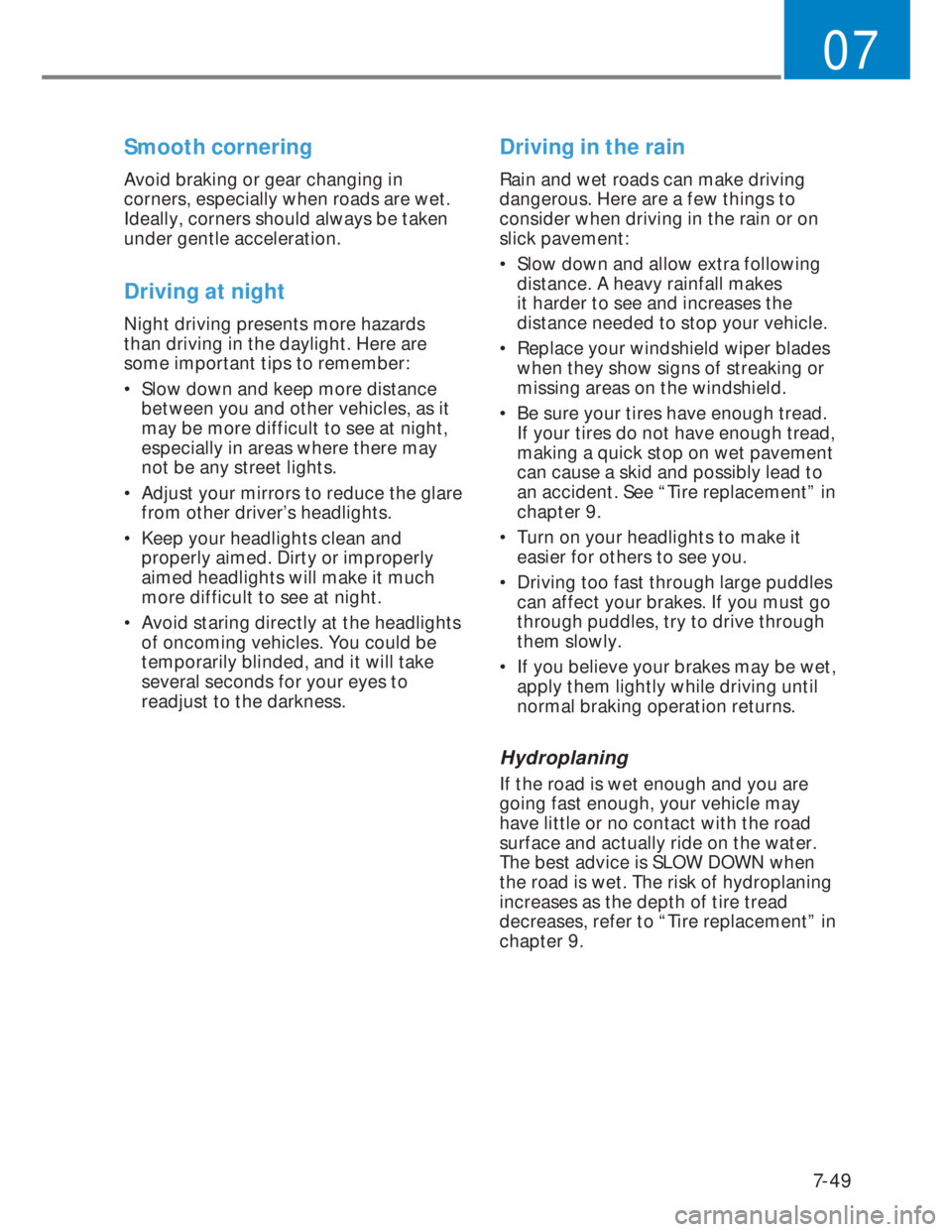
7-49
07
Smooth cornering
Avoid braking or gear changing in
corners, especially when roads are wet.
Ideally, corners should always be taken
under gentle acceleration.
Driving at night
Night driving presents more hazards
than driving in the daylight. Here are
some important tips to remember:
• Slow down and keep more distance
between you and other vehicles, as it
may be more difficult to see at night,
especially in areas where there may
not be any street lights.
• Adjust your mirrors to reduce the glare
from other driver’s headlights.
• Keep your headlights clean and
properly aimed. Dirty or improperly
aimed headlights will make it much
more difficult to see at night.
• Avoid staring directly at the headlights
of oncoming vehicles. You could be
temporarily blinded, and it will take
several seconds for your eyes to
readjust to the darkness.
Driving in the rain
Rain and wet roads can make driving
dangerous. Here are a few things to
consider when driving in the rain or on
slick pavement:
• Slow down and allow extra following
distance. A heavy rainfall makes
it harder to see and increases the
distance needed to stop your vehicle.
• Replace your windshield wiper blades
when they show signs of streaking or
missing areas on the windshield.
• Be sure your tires have enough tread.
If your tires do not have enough tread,
making a quick stop on wet pavement
can cause a skid and possibly lead to
an accident. See “Tire replacement” in
chapter 9.
• Turn on your headlights to make it
easier for others to see you.
• Driving too fast through large puddles
can affect your brakes. If you must go
through puddles, try to drive through
them slowly.
• If you believe your brakes may be wet,
apply them lightly while driving until
normal braking operation returns.
Hydroplaning
If the road is wet enough and you are
going fast enough, your vehicle may
have little or no contact with the road
surface and actually ride on the water.
The best advice is SLOW DOWN when
the road is wet. The risk of hydroplaning
increases as the depth of tire tread
decreases, refer to “Tire replacement” in
chapter 9.
Page 341 of 444

10
Wiper blades ............................................................................................... 10-45
Blade inspection .....................................................................................................10-45
Blade replacement .................................................................................................10-45
Battery ......................................................................................................... 10-48
For best battery service ........................................................................................ 10-48
Battery capacity label
........................................................................................... 10-50
Battery recharging ................................................................................................ 10-48
Reset items ............................................................................................................ 10-49
Battery replacement
............................................................................................. 10-49
Tires and wheels ......................................................................................... 10-50
Tire care ................................................................................................................. 10-50
Recommended cold tire inflation pressures ....................................................... 10-50
Checking tire inflation pressure
............................................................................ 10-51
Tire rotation
............................................................................................................10-52
Wheel alignment and tire balance ........................................................................10-53
Tire replacement ....................................................................................................10-54
Wheel replacement
................................................................................................10-55
Tire traction
............................................................................................................10-55
Tire maintenance .................................................................................................. 10-56
Tire sidewall labeling ............................................................................................. 10-56
Low aspect ratio tire.............................................................................................. 10-59
Fuses ............................................................................................................. 10-61
Instrument panel fuse replacement .....................................................................10-62
Engine compartment panel fuse replacement ................................................... 10-63
Fuse/relay panel description
................................................................................ 10-64
Light bulbs .................................................................................................... 10-75
Headlight, Position Light, Turn signal Light bulb replacement ........................... 10-76
Side repeater light replacement ........................................................................... 10-81
Rear combination light bulb replacement
........................................................... 10-81
High mounted stop light replacement ................................................................ 10-85
License plate light bulb replacement .................................................................. 10-85
Interior light bulb replacement ............................................................................ 10-86
Page 348 of 444

10-9
10
While operating your vehicle:
• Note any changes in the sound of the
exhaust or any smell of exhaust fumes
in the vehicle.
• Check for vibrations in the steering
wheel. Notice any increased steering
effort or looseness in the steering
wheel, or change in its straight-ahead
position.
• Notice if your vehicle constantly turns
slightly or “pulls” to one side when
traveling on smooth, level road.
• When stopping, listen and check for
unusual sounds, pulling to one side,
increased brake pedal travel or “hard-
to-push” brake pedal.
• If any slipping or changes in the
operation of your transmission occurs,
check the transmission fluid level.
• Check the parking brake.
• Check for fluid leaks under your
vehicle (water dripping from the air
conditioning system during or after
use is normal).
At least monthly:
• Check the coolant level in the engine
coolant reservoir.
• Check the operation of all exterior
lights, including the stoplights, turn
signals and hazard warning flashers.
• Check the inflation pressures of all
tires including the spare for tires that
are worn, show uneven wear, or are
damaged.
• Check for loose wheel lug nuts.
At least twice a year
(i.e., every Spring and Fall):
• Check the radiator, heater and air
conditioning hoses for leaks or
damage.
• Check the windshield washer spray
and wiper operation. Clean wiper
blades with clean cloth dampened
with washer fluid.
• Check the headlight alignment.
• Check the muffler, exhaust pipes,
shields and clamps.
• Check the lap/shoulder belts for wear
and function.
At least once a year:
• Clean the body and door drain holes.
• Lubricate the door hinges and checks,
and hood hinges.
• Lubricate the door and hood locks and
latches.
• Lubricate the door rubber
weatherstrips.
• Check the air conditioning system.
• Inspect and lubricate Automated
manual transmission linkage and
controls.
• Clean the battery and terminals.
• Check the brake/clutch fluid level.